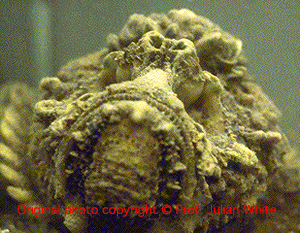
Used for neutralising envenoming by the Australian stonefish, Synanceia trachynis. It is made from horse IgG. Each ampoule contains 2000 units of neutralising capacity against the target venoms. Average volume per ampoule is 1.5-3mL. The immunising species is the stonefish, Synanceia trachynis.
The stonefish is a rather unattractive squat fish with a most irregular "skin" which assists its superb camouflage as it sits on old coral or debris. There are a series of erectile dorsal spines, which, with the associated venom glands, are the means of envenoming potential predators.

Stonefish are found throughout northern Australian waters, especially in association with coral reefs. They are mostly encountered in shallow water, where, owing to their excellent camouflage, they may be stepped on by accident, or picked up by the unwary.
The venom is multicomponent, with neurotoxic, myotoxic, cardiotoxic and cytotoxic effects in experimental animals. A presynaptic neurotoxin has been described from the venom. While the venom can cause haemolysis, this is not a significant problem in people envenomed by the stonefish. The venom may also cause vascular leakage.
Most stonefish stings occur when the fish is stepped on, or less commonly, when picked up incautiously. No confirmed deaths from stonefish sting have occurred in Australia, but deaths are reported for some stonefish in the Indo-Pacific. Instant and severe pain is a constant feature of stings, followed by local swelling, which may be marked, tenderness and a blue discolouration of skin surrounding the sting penetration site. Dizziness, nausea, hypotension, collapse, cyanosis and pulmonary oedema have been described, though are by no means common. Tissue necrosis at the sting site is not seen.
As with most antivenoms, CSL Stonefish Antivenom should only be given if there is clear evidence of envenoming. See potential contraindications. It should be given only IM, not IV. Prior to commencing antivenom therapy, make sure everything is ready to treat anaphylaxis, should this occur. Specifically, have adrenaline ready to give. In any significant stonefish sting, with severe local pain, it is worth considering antivenom therapy. For 1 to 2 spine puncture wounds, give 1 vial of CSL Stonefish Antivenom IM. For 3 to 4 spine puncture wounds give 2 vials of CSL Stonefish Antivenom IM. For more than 4 spine puncture wounds give 3 vials of CSL Stonefish Antivenom.
The use of CSL Stonefish Antivenom in stings by other species of scorpionfish is not clearly recommended, but there is limited evidence that it may be beneficial (eg possibly bullrout stings, Notesthes robusta). The potential risks of immediate and delayed adverse reactions to antivenom should be carefully considered before using this antivenom for other than stonefish stings.
The use of adrenaline as pre-treatment when using antivenoms is still being debated. The risk of anaphylaxis varies from antivenom to antivenom. People who have had previous exposure to equine derived products may be at greater risk. It is recommended that the Product Information be read before use and if necessary contact be made with a specialist in the field.
If there is either a sudden fall in blood pressure or bronchospasm, after giving the antivenom, then give adrenaline by subcutaneous injection, give 100% O2 and IV fluids (Haemaccel®).
If adrenaline is to be given (by subcutaneous injection), use a 1:1000 solution. For adults give 0.5mL (0.5mg) initially. For children give 0.01mg/kg initially. Repeat as necessary and try IM injection if no response to SC injection.
If bronchospasm is the major problem, try nebulised adrenaline, 2mL of
Any patient who has received antivenom may develop serum sickness, from 4 to 14 days later. Before leaving hospital, they should be advised of the symptoms of serum sickness, such as rash, fever, joint aches and pains, malaise, and told to return immediately for review and probable commencement of oral steroid therapy. For patients receiving multiple ampoules of CSL Stonefish Antivenom, it may be helpful to give a short course of oral steroids as prophylaxis. If there was major envenoming, organise follow up. This is usually not necessary for minor envenoming.